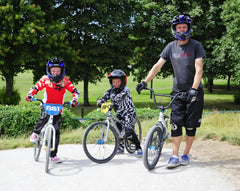Packa Shack's Guide to BMX
Packa Shack and BMX a match made in heaven, extra space, shelter, privacy, comfort where ever you, your BMX mad family and your vehicle can get to.

A beginners guide to BMX with thanks to the Wikipedia fairies...
BMX began during the early 1970s in the United States when children began racing their bicycles on dirt tracks in southern California, inspired by the motocross stars of the time. The size and availability of the Schwinn Sting-Ray and other wheelie bikes made them the natural bike of choice for these races, since they were easily customized for better handling and performance. BMX racing was a phenomenon by the mid-1970s. Children were racing standard road bikes off-road, around purpose-built tracks in California.[1] The 1972 motorcycle racing documentary On Any Sunday is generally credited with inspiring the movement nationally in the United States; its opening scene shows kids riding their Sting-Rays off-road. By the middle of that decade, the sport achieved critical mass, and manufacturers began creating bicycles designed especially for the sport.
In the UK, BMX was a craze which took off in the early 1980s, specifically 1982/3, when it became the "must have" bicycle for children and teenager. Previously a small niche area, BMX exploded at this time into the dominant bicycle for the younger rider, with older teenagers and even adults becoming known names through publications like BMX Bi weekly, featuring big names like Tim March and Andy RuffelI. The shift to Freestyle from Racing came in 1985 with popular styling moving from chrome frames and contrasting components in black blue or red being the norm, to brightly coloured bikes in one colour only, including their mag wheels and even matching tyres. Perhaps the most iconic of this era was the all white Skyway models, with their famous red/Blue decals, capturing the excess of mid 1980s fashions perfectly. Because BMX exploded into Britain's streets so suddenly, it was perhaps inevitable that it would implode with similar speed, when the kids who rode the bikes left school and went to work. This was indeed the case, as by 1986/7 sales in the UK had dropped off dramatically, with the new ATB or "Mountain Bike" taking off and soon to become the generic adult bicycle, again from California where it had begun in the mid 1970s.[2] As Mountain Bikes began to dominate, this was the period when the millions of BMX bikes sold during the early/mid 1980s went through their "worthless" period, as the Raleigh Chopper had done during the BMX boom. A new spike in BMX came in the 1990s but fashions had changed. Colour schemes were low key, mirroring street fashion, the opposite to the bright colours and flashy decals of the 1980s. The influence of the "trendies" had given way to the next generation, with bottle green or even Brown frames, black components and a general lack of visual identification. Mag wheels were firmly out of fashion. The original UK BMX scene was now history.